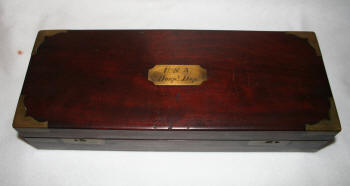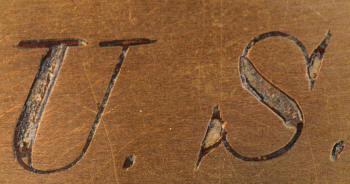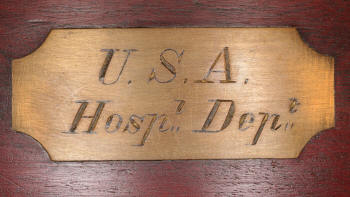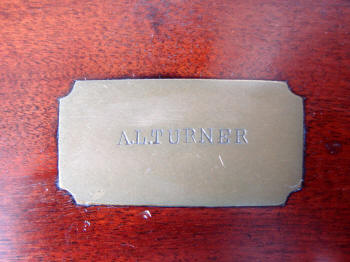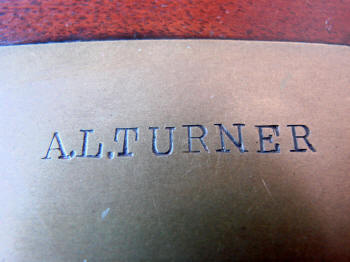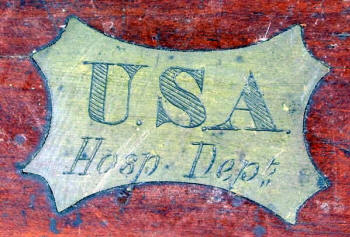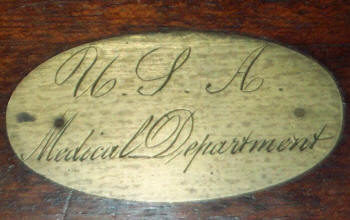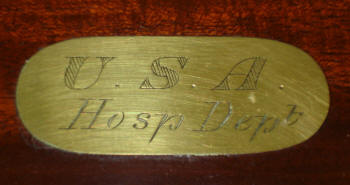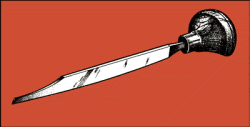Civil War Surgical Set Brass Cartouche Engraving
One of the detection methods to use for identification of 'faked' Civil War surgical sets is to identify the type of engraving techniques used to inscribe the brass plate (cartouche) on the top of the mahogany wood case. Fakes will usually have been marked with a technique other than hand engraving due to the ease of producing non-engraved brass cartouches for a surgical set. With fakes, it is usually obvious the brass plate has been removed and re-cemented, where as the originals are precision cut into place and show on large or ragged space between the wood and brass and no marks from having been removed and re-cemented.
After the brass was hand-engraved, not stamped, not laser-cut, and not impressed with struck steel dies, the plate was precisely inlayed into the wood, glued, and the whole case was given a coat of varnish by the maker. This varnish and other debris can be noted in the cut marks that form the letters of the engraved 'U.S.A. Hosp'l. Dep't' in the following photos:
Click images to enlarge
Above, the engraving cut-marks are long strokes with a point on each end of the stroke from where the chisel started and finished the cut. The font of the letters are consistent with the period. This engraving is not accomplished with a metal punch or created with a series of dots, but with deep cuts into the brass. Click on the image to examine the details. This particular example is from a Geo.Tiemann & Co., New York, c. 1861 set. The engraving, like handwriting, may vary with the artisan and the maker.
Below, a post-Civil War example of individual die-struck imprinting of a brass plate on a Civil War set brass plate and not a particularly well done job judging by the spacing and irregularity of the strikes.
Below is an example from Hernstein and Son, also in New York, c. 1861. on this small trepanning case, only 'U.S.A' is engraved on the brass plate. Of note is the diagonal marks which followed an inked pattern drawn on the brass before the engraving was performed.
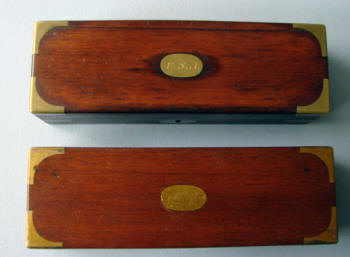
Click images to enlarge
Obviously engraving being by-hand and not mechanically impressed or struck, the technique and result will vary from set to set and maker to maker, but the font and general flow of the engraving will be very similar.
Contemporary engraving looks much different because hand-writing techniques and habits have changed drastically in the past one hundred years and those quirks of the eye and hand show up in the 'look' of the engraving. It's how the government detects forged money and art experts detect forged artwork.
Examples of other makers and techniques are shown below and were taken from 'known' authentic maker examples out of this collection from Hosp. Dept. and Medical Dept. sets.
Hand engravers use a tool called the graver. It is a piece of rectangular steel rod with one end sharpened and the other end finished with a rounded wood knob that is cradled in the palm of the hand. The graver is pushed along the surface of the metal leaving an angled groove. The cut is very bright and shiny and makes for a very crisp line. Gravers can have different shapes on the cutting end for a variety of decorative techniques. The shank of the graver can also be bent so it can used on the inside of small spaces.
Hand engraving is different from other decorative techniques in the sharpness of the lines and its permanence. Machine engraving cannot cut as deeply as the hand technique. Stamping and etching are sometimes confused with hand engraving, but the result is not as sharp. Lasers and die cutting can also be used to cut into metal but the results look machined rather than finely crafted. Eric Margry Hand Engraving 2009
